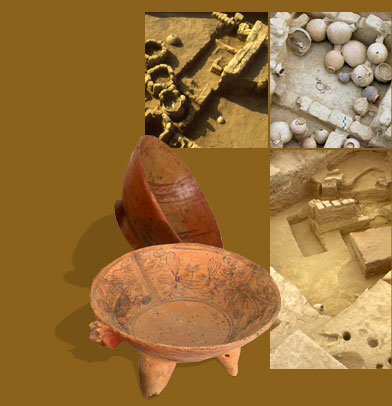In 1991, when investigations at San José de Moro began, excavation units had dimensions limited to 2 by 2 m at the largest, as our objectives were oriented toward responding to pointed questions of the site’s cultural superposition and the specific characteristics of the tombs and their contents. After 1996, the dimensions of the excavation areas were increased to units of 5 by 5 m, which permitted us to observe the funerary areas in their totality as well as enabled contextualization of those areas with other evidence of domestic and/or architectural layout.
Since the year 2000, the excavation units have measured 10 by 10 m, an ample size allowing broad vision and understanding of the relationships between adjacent funerary and ceremonial areas. Excavation of units of such dimensions has permitted us to document simultaneously up to 20 related tombs at the same archaeological strata, together with spaces for production and storage of chicha.
The excavations at San José de Moro are carried out by levels of deposition, registering each element in three dimensions and describing its relation to the cultural layers with which it is associated. The excavation of the funerary contexts is carried out in accordance with a digging plan which permits the use of diverse methods corresponding to the three types of tombs discovered at the site: pit, boot-shaped, and chamber.
The pit tombs are the most simple. They consist of long, very superficial graves that usually contained one individual accompanied by a few offerings, the excavation of which entails simply exposing the contents in their totality. Appearing frequently in conjunction with the later occupations of the site during the Transitional and Lambayeque periods, these tombs were also found dating from the Moche period.
Boot-shaped tombs are the most representative of the Middle to Late Moche periods. These tombs have an access shaft (of 2 m average depth) which leads to a lateral vault or chamber where an individual was located along with corresponding offerings; afterwards this vault was sealed with adobes or mud-bricks. The excavation of this type of tomb entails clearing of the access shaft to locate the adobe seal. Excavation continues along the side of the shaft where the funerary vault is located, leaving a profile which illustrates the structure of the internal elements of the tomb.
The chamber tombs are typically the most complex funerary contexts of SJM. They consist of a quadrangular structure made of adobes and roofed with algarrobo beams; they could have niches in the walls, or benches at their edges – their size and contents varied with the period and/or phase with which they are associated (Moche Late A, B, or C; or Early or Late Transitional). Excavation of this type of area exposes the entire perimeter of the chamber with the objective of determining its dimensions, and then continues with the recording of its interior, following arbitrary levels of excavation.

|



